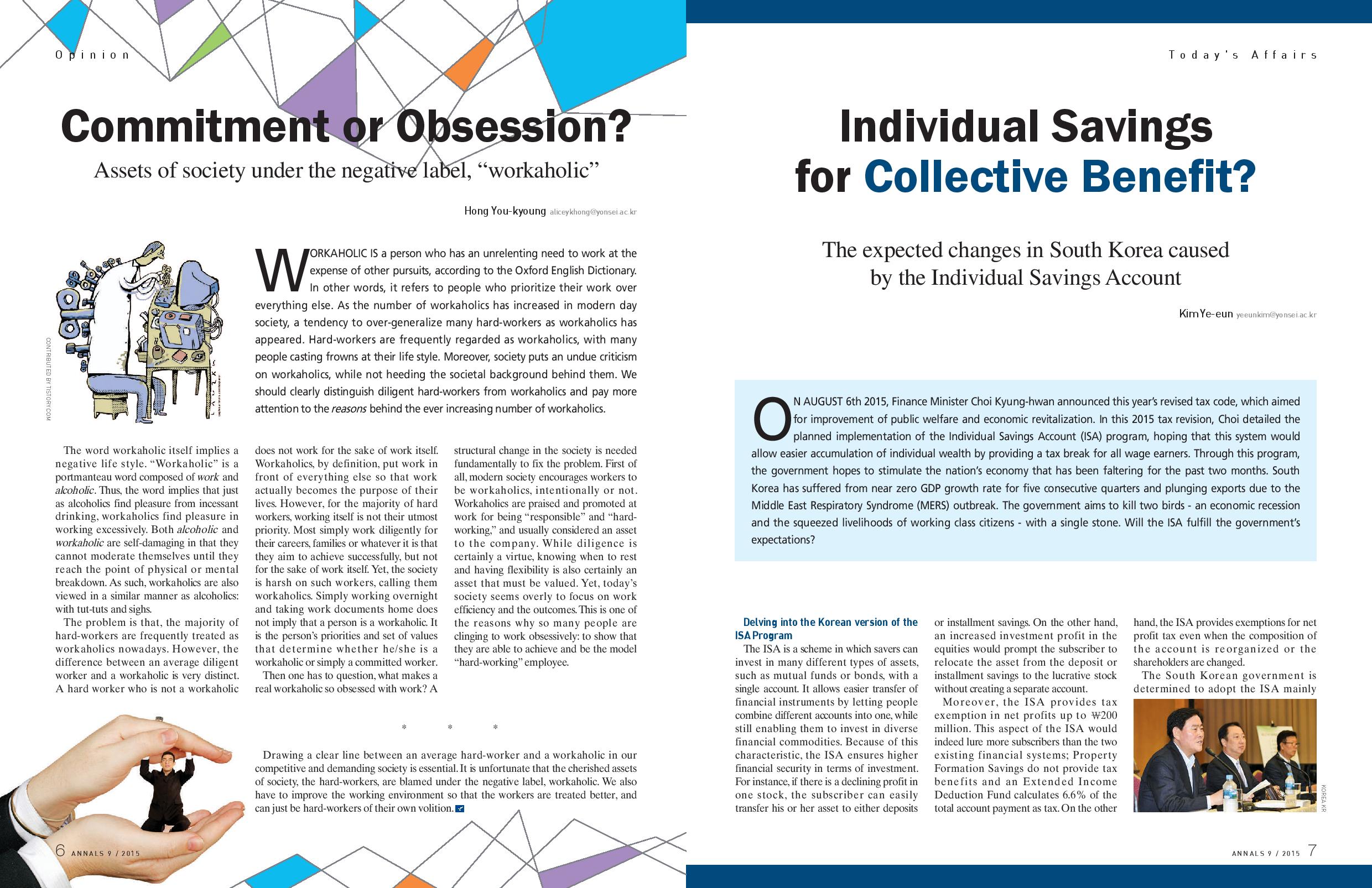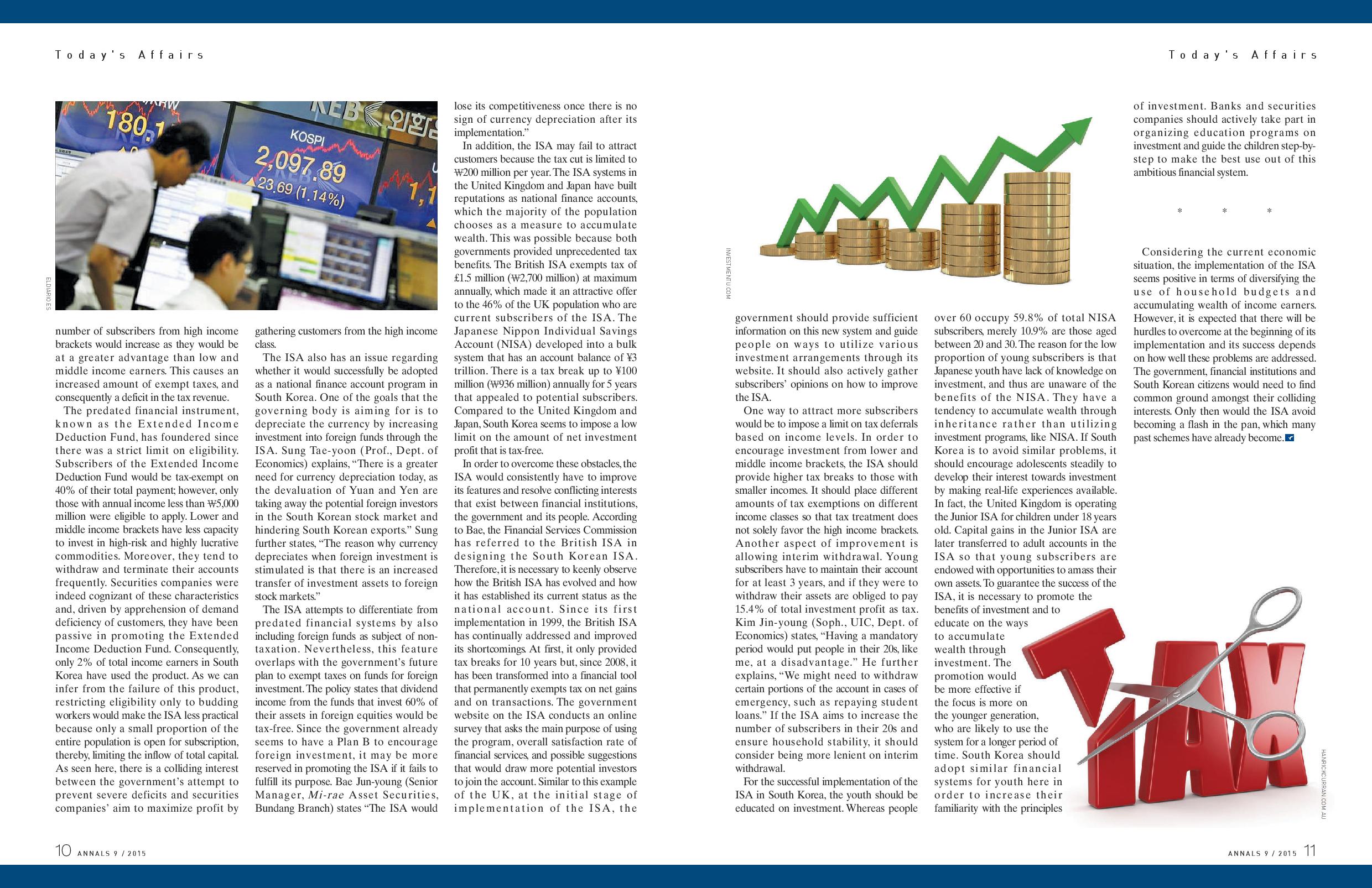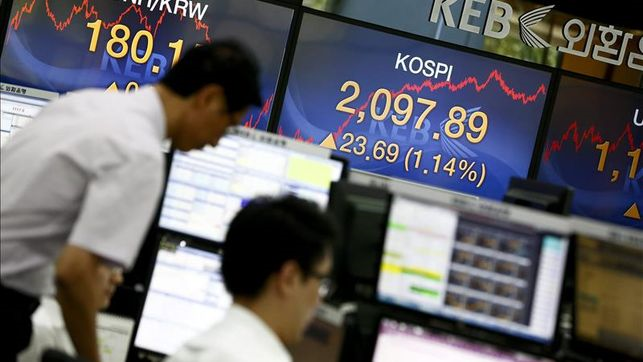The expected changes in South Korea caused by the Individual Savings Account
 | ||
 | ||
 | ||
 | ||
ON AUGUST 6th 2015, Finance Minister Choi Kyung-hwan announced this year’s revised tax code, which aimed for improvement of public welfare and economic revitalization. In this 2015 tax revision, Choi detailed the planned implementation of the Individual Savings Account (ISA) program, hoping that this system would allow easier accumulation of individual wealth by providing a tax break for all wage earners. Through this program, the government hopes to stimulate the nation’s economy that has been faltering for the past two months. South Korea has suffered from near zero GDP growth rate for five consecutive quarters and plunging exports due to the Middle East Respiratory Syndrome (MERS) outbreak. The government is under a mission to kill two birds - an economic recession and livelihoods of working class citizens - with a single stone. Will the ISA fulfill the government’s expectations?
Delving into the Korean version of the ISA Program
The ISA is a scheme in which savers can invest in many different types of assets, such as mutual funds or bonds, with a single account. It allows easier transfer of financial instruments by letting people combine different accounts into one, while still enabling them to invest in diverse financial commodities. Because of this characteristic, the ISA ensures higher financial security in terms of investment. For instance, if there is a declining profit in one stock, the subscriber can easily transfer his or her asset to either deposits or installment savings. On the other hand, an increased investment profit in the equities would prompt the subscriber to relocate the asset from the deposit or installment savings to the lucrative stock without creating a separate account.
Moreover, the ISA provides tax exemption in net profits up to 200 million. This aspect of the ISA would indeed lure more subscribers than the two existing financial systems; Property Formation Savings does not provide tax cuts and Extended Income Deduction Fund calculates 6.6% of the total account payment as tax. On the other hand, the ISA provides exemptions for net profit tax even when the composition of the account is reorganized or the shareholders are changed.
The South Korean government is determined to adopt the ISA mainly because the Bank of Korea pegged the interest rate at a low 1% range. Therefore, income earners in South Korea would not be able to yield high revenue merely through deposit, which is the main means of wealth accumulation in the nation. Predicting difficulties in ensuring household stability, the government believes stimulating investment through the ISA program would be the ideal new method for amassing assets. Indeed, South Koreans have been showing a passive attitude when it comes to investment as demonstrated from low proportion of financial assets in the total household budget. According to the Ministry of Strategy and Finance, South Korean households hold 26.8% of its budget as financial assets, which is significantly lower than that of Japanese households at 60.1%. In order to secure more financial wealth in times of low interest rates, there needs to be a vitalization of the investment sector. The government expects to accomplish just that through the adoption of the ISA.
Example portfolio compositions of the ISA
| | Very Low Risk | Low Risk | Middle Risk |
| Portfolio: | Deposit, Money Market Fund | A balanced composition of Deposit, Bonds, Index Fund | A mixture of domestic and foreign stocks, Bonds and Equity Linked Security (ELS) |
| Profit Aim: | 2% annual | 4% annual | 8% annual |
| Before-tax profit: | 300 million | 1,000 million | 2,000 million |
| After-tax profit: | 258 million | 846 million | 1,164 million |
What would South Korea yield from the ISA?
Adoption of the ISA program in South Korea is expected to bring benefits to individuals and the nation as a whole. One of the benefits is that the system would promote investment from a young age since the investment process will become simplified. Currently, financial services such as a retirement annuities and pension savings are provided different amounts of tax exemptions depending on their types and financial institutions that serve as a bridge between stakeholders and corporate. Nevertheless, with the introduction of the ISA, subscribers would be able to manage different types of assets with ease as the tax break is guaranteed at net profit of 200 million regardless of their type.
In addition, an account can be more varied in terms of its composition, within the ISA system. Customers would be able to organize their portfolios with increased shares of financial items that are highly stable and lucrative. This is possible as they universally enjoy the tax-free status and, thus, are less burdened financially. Subscribers can choose types of financial services incorporated into the ISA that suit their demand. If they prioritize stability, market neutral funds and derivative-linked securities should mainly occupy their accounts; if they decide to concentrate on raising a profit with some risk, they should increase the portion of commodity stocks. ISA subscribers can also adopt a mixture of financial services that have stable dividend incomes and high-risk bond funds, all with a single account.
Due to increased investment from the younger generation, there will be a steady influx of assets into the capital market. The government is planning to enforce 3 years of mandated use for young income earners who are willing to subscribe to the ISA. Restricting withdrawal of assets from the account would ensure a steady supply of capital gains into the market and act as a growth engine for the economy. For instance, the United Kingdom has provided outright fiscal and tax support through the implementation of the ISA so that its people easily amass wealth through investment. As a result, the British ISA has accumulated £4,696 billion in total. This capital has stabilized the nation’s market that, even after the 2008 financial crisis, the amount of reserves spiked 14.2% annually for 5 years. Yet, investment is not as widely as utilized in South Korea. As the current dividend rate is 1.33% and is 0.41% lower than the interest rate, South Koreans prefer saving over investment. This, in turn, reduces the supplies of equities dividend and triggers less investment into commodities. Investment needs to be reinvigorated in order to bolster the market. If the ISA were to be implemented, it would strengthen the market by increasing the number of stock transactions and securing continual inflow of capital into the investment sector.
People in their 20s would benefit most from the ISA by selecting certain types of financial services that would stably enable them to accumulate wealth without tax. One of these services is the Money Market Fund (MMF). An asset management company forms a fund with its customers’ assets and raises profits through investing into short-term financial instruments. It then distributes the earnings to its customers. The MMF ensures a relatively high dividend rate due to the high interest rate of its commodities. Moreover, there is no restriction on the amount and the period of investment.
Another item is the Index Fund. In this fund, subscribers gain dividend income by investing in stocks whose index best reflects Korea Composite Stock Price Index (KOSPI). Since the amount of dividend income is proportionate to the change in the price-earnings ratio, the goal is clear and equities investment strategy is transparent that even those without expertise are able to comprehend the fundamentals. Index Fund also reduces risk by dispersing investment in different companies and attempts to avoid situations where earnings are low comparative to the amount of investment.
The third type that ensures stable wealth formation is the Market Neutral Fund. It aims to gain steady earnings without being influenced by the market price. As the fund is unaffected by versatile stock price, the investors would raise profits higher than the actual interest rate. The actual interest rate best reflects the value of money because it is determined by the corporate bond yields. The ISA program enables its subscribers to gain significant profit from these highly stable financial items.
Colliding Aims, Uncertain Path to Success
Although the ISA program may provide benefits, there are certain aspects that need to be addressed for the program to be successfully implemented. The government is currently facing a dilemma on whether there should be a limit on income eligibility for subscription to the ISA. It has to decide whether to fill in the tax revenue deficit or to remove the restriction on this eligibility. With this new system, there will be a decline in tax revenue of 5,500 billion. This is explained by the Financial Services Commission’s decision to abolish income limit on subscription in a bid to attract more potential investors. If the income ceiling on eligibility is removed, the number of subscribers from high income brackets would increase as they would be at a greater advantage than low and middle income earners. This causes increased amount of exempt taxes, and consequently deficit in the tax revenue.
The predated financial instrument, which is the Extended Income Deduction Fund, has foundered since there was strict limit on eligibility. Subscribers of Extended Income Deduction Fund would be tax-exempt on 40% of their total payment; however, only those with annual income less than 5,000 million were eligible to apply. Lower and middle income brackets have less capacity to invest in high-risk and highly lucrative commodities. Moreover, they tend to withdraw and terminate their accounts frequently. Securities companies were indeed cognizant of these characteristics and, driven by apprehension of demand deficiency of customers, they have been passive in promoting the Extended Income Deduction Fund. Consequently, only 2% of total income earners in South Korea have used the product. As referred from the failure of the financial item, restricting eligibility only to budding workers would make the ISA less pragmatic because only a small proportion of the entire population is open for subscription, thereby, limiting the inflow of total capital. As seen here, there is a colliding interest between the government’s attempt to prevent severe deficits and securities companies’ aim to maximize profit by gathering customers from high income class.
The ISA also has an issue regarding whether it would successfully be adopted as a national finance account program in South Korea. One of the goals that the governing body is aiming for is to depreciate the currency by increasing investment into foreign funds through the ISA. Sung Tae-yoon (Prof., Dept. of Economics) explains, “There is a greater need for currency depreciation today, as the devaluation of Yuan and Yen are taking away the potential foreign investors of the South Korean stock market and hindering South Korean exports.” Sung further states, “The reason why currency depreciates when foreign investment is stimulated is that there is an increased transfer of investment asset to foreign stock market.”
The ISA attempts to differentiate from predated financial systems by also including foreign funds as subject of non-taxation. Nevertheless, this feature overlaps with the government’s future plan to exempt tax on the fund for foreign investment. The policy states that dividend income from the funds that invest 60% of their asset in foreign equities would be tax-free. Since the government already seems to have a Plan B to encourage foreign investment, it may be more reserved in promoting the ISA if it fails to fulfill its purpose. Bae Jun-young (Senior Manager, Mi-rae Asset Securities, Bundang Branch) states “The ISA would lose its competitiveness once there is no sign of currency depreciation after its implementation.”
In addition, the ISA may fail to attract customers because the tax cut is limited to 200 million per year. The ISA in the United Kingdom and Japan have built reputations as national finance accounts which the majority of the population chooses as a measure to accumulate wealth. This was possible because both governments provided unprecedented tax benefits. The British ISA exempts tax of £1.5 million (2,700 million) at maximum annually, which came as an attractive offer to 46% of the UK population who are the current subscribers of the ISA. The Japanese Nippon Individual Savings Account (NISA) developed into a bulk system that has an account balance of ¥3 trillion. There is a tax break up to ¥100 million (936 million) annually for 5 years that appealed to potential subscribers. Compared to the United Kingdom and Japan, South Korea seems to impose a low limit on the amount of net investment profit that is tax-free.
In order to overcome these obstacles, the ISA would consistently have to improve its features and resolve conflicting interests that exist between financial institutions, the government and its people. According to Bae, Financial Services Commission has referred to the British ISA in designing the South Korean ISA. Therefore, it is necessary to keenly observe how the British ISA has evolved and how it has established its current status as the national account. Since its first implementation in 1999, the British ISA has continually complemented its shortcomings. At first, it only provided tax breaks for 10 years but since 2008, it transformed into a financial tool that permanently exempts tax on net gain and on transaction. The government website on the ISA conducts an online survey that asks the main purpose of using the program, overall satisfaction rate of financial services, and possible suggestions that would draw more potential investors to join the account. Like this, at the initial stage of implementation of the ISA, the government should provide sufficient information on this new system and guide people on ways to utilize various investment arrangements through its website. It should also actively gather subscribers’ opinions on how to improve the ISA.
One way to attract more subscribers would be to impose a limit on tax deferrals based on income levels. In order to encourage investment from lower and middle income brackets, the ISA should provide higher tax cuts to those with smaller incomes. It should place different amounts of tax exemptions on different income classes so that tax treatment does not solely favor the high income brackets. Another aspect of improvement is allowing interim withdrawal. Young subscribers have to maintain its account for at least 3 years and if they were to withdraw their assets, are obliged to pay 15.4% of total investment profit as tax. Kim Jin-young (Soph., UIC, Dept. of Economics) states “Having a mandatory period would put people in their 20s like me at a disadvantage.” He further explains, “We might need to withdraw certain portions of the account in cases of emergency, such as repaying student loans.” If the ISA aims to increase the number of subscribers in their 20s and ensure household stability, it should consider being more lenient on interim withdrawal.
For the successful implementation of the ISA in South Korea, the youth should be educated on investment. Whereas people over 60 occupy 59.8% of total NISA subscribers, merely 10.9% are those aged between 20 and 30. The reason for the low proportion of young subscribers is that Japanese youth have lack of knowledge on investment and thus, are unaware of the benefits of the NISA. They have a tendency to accumulate wealth through inheritance rather than utilizing investment programs, like NISA. If South Korea were to avert from undergoing a similar procedure, it should encourage adolescents to steadily develop their interest towards investment by making real-life experiences available. In fact, the United Kingdom is operating the Junior ISA for children under 18 years old. Capital gains in the Junior ISA are later transferred to adult accounts in the ISA so that young subscribers are endowed with opportunities to amass their own asset. To guarantee the success of the ISA, it is necessary to promote the benefits of investment and to educate on the ways to accumulate wealth through investment. The promotion would be more effective if the focus is more on the younger generation, who are likely to use the system for a longer period of time. South Korea should adopt similar financial systems for the youth in order to increase their familiarity with the principles of investment. Banks and securities companies should actively take part in organizing education programs on investment and guide the children step-by-step to make the best use out of this ambitious financial system.
* * *
Considering the current economic situation, the implementation of the ISA seems positive in terms of diversifying the use of household budgets and accumulating wealth of income earners. However, it is expected that there will be hurdles to overcome at the beginning of its implementation and its success depends on how well these problems are addressed. The government, financial institutions and South Koreans would need to find common ground amongst their colliding interests. Only then would the ISA avoid becoming a flash in the pan, which the past schemes have already well experienced.

